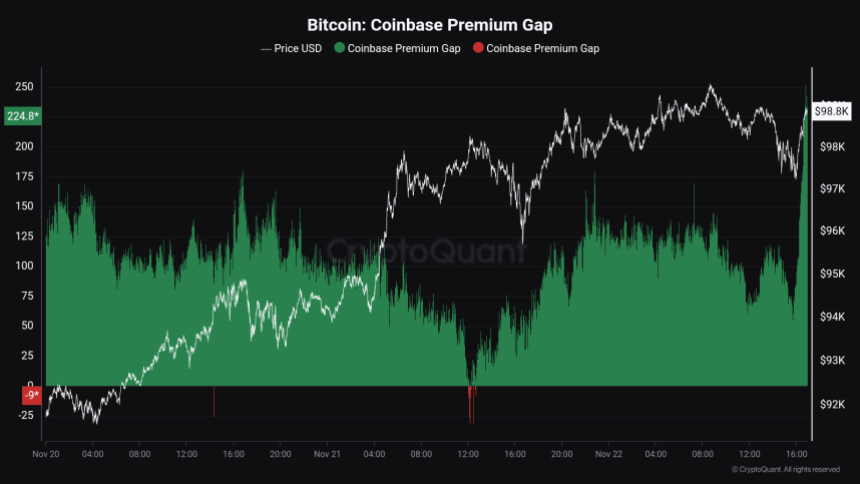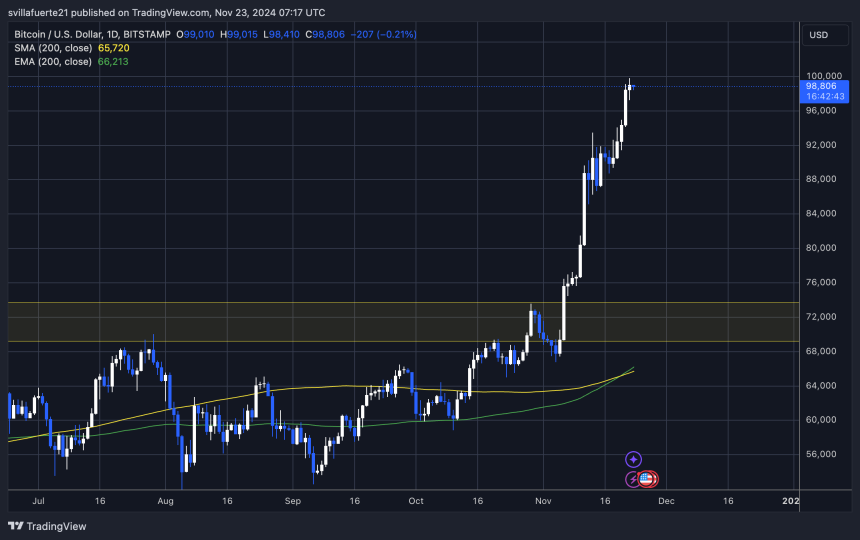Bitcoin
Is “Uptober” making a comeback?
Published
2 months agoon
By
admin

Could Bitcoin’s historic “Uptober” returns repeat themselves this year, especially after its best September performance ever, or are we set for a new twist in Bitcoin’s price action?
October brings back hopes
As October rolls around, the Bitcoin (BTC) community is buzzing with excitement. Historically, this has been Bitcoin’s favourite time to shine, and the buzzword ‘Uptober’ is making a comeback.
But let’s rewind a bit and talk about September. Traditionally, it’s been a rough month for Bitcoin, with prices often taking a hit. In fact, from 2017 to 2022, every September ended in the red for Bitcoin. For years, it was consistently one of the worst-performing months for BTC.
However, 2024 had other plans. Instead of stumbling, Bitcoin surged! For the first time in years, September ended with a 9.3% return — its best performance since Bitcoin’s inception, according to Coinglass data.
To put this in perspective, BTC only managed a 3.91% gain in September last year. As of Sep. 30, Bitcoin is trading at $64,600, having climbed about 2% in the past week.
A lot of this momentum comes from recent moves by the U.S. Federal Reserve. On Sep. 18, the Fed cut interest rates by 50 basis points, giving the market a solid boost.
Now, October has always been a standout month for Bitcoin, with an average return of 22.9%. With BTC already showing strength as we leave September behind, what could be next for Bitcoin?
Factors driving Bitcoin’s October outlook
As we head into October, several key factors seem to be aligning for Bitcoin, setting the stage for a potentially bullish month. Let’s break them down one by one.
Post-halving effect
Bitcoin’s fourth halving event occurred in April 2024, slashing mining rewards in half from 6.25 BTC per block to 3.125 BTC.
Historically, this supply reduction has often sparked bullish price movements, although not immediately. Bitcoin tends to follow a post-halving pattern, swinging between highs and lows before building key momentum.
Interestingly, research suggests that Bitcoin’s price cycles typically start gaining traction around 170 days after a halving, peaking roughly 480 days later.
With October marking about 170 days since the most recent halving, many are speculating that this could be the start of a major upward movement for BTC.
What makes this even more intriguing is the fact that the final quarter of the year, especially during halving cycles, has historically been bullish. For example, in Q4 of 2012, Bitcoin surged 97.7%, Q4 of 2016 saw gains of 58.4%, and Q4 of 2020 delivered an astonishing 168.9% rally.
If history is any indicator, Q4 of 2024 could follow this pattern, with October potentially setting the stage for a strong rally.
Election heat
The 2024 U.S. election race is adding fuel to Bitcoin’s fire, with both major candidates stepping into the crypto conversation.
Former President Donald Trump, once a crypto sceptic, has made a critical pivot. Earlier this year, in May, he began accepting crypto donations for his campaign — a move that immediately caught the crypto community’s attention.
In June, Trump further reinforced his pro-crypto stance by voicing support for Bitcoin miners, expressing hope that the remaining Bitcoin supply would be mined domestically.
He didn’t stop there. At the end of July, Trump made headlines by attending the Bitcoin Conference in Nashville as the main guest, where he proposed creating a national strategic reserve of Bitcoin.
And, to cap things off, on September 16, Trump launched his own decentralized finance project called “World Liberty Financial,” solidifying his deepening involvement in the crypto space.
On the other side, Vice President Kamala Harris has also started courting the crypto community, although with more caution. After a long period of silence, she’s finally making statements that show she’s warming up to the sector.
In a recent speech in Pittsburgh, Harris highlighted the importance of maintaining U.S. dominance in blockchain technology, a critical backbone of the crypto ecosystem.
Her campaign followed up by releasing a policy document that promised to “encourage innovative technologies like AI and digital assets,” signalling a nod toward the importance of cryptocurrencies like Bitcoin.
With both major candidates now dipping their toes into the crypto waters, the political landscape seems to be shaping up favourably for Bitcoin, especially as election season heats up.
Stable macroeconomic environment
The macroeconomic environment is also playing a key role in Bitcoin’s outlook for October. Despite some mixed signals, there’s reason to remain optimistic.
The U.S. economy added 142,000 jobs in August, slightly more than in July, which has boosted market confidence. However, job revisions from previous months suggest the labour market might not be as strong as it initially appeared.
Inflation, another critical factor, seems to be cooling—at least on the surface. In August, the Consumer Price Index (CPI) hit its lowest level since February 2021, landing at 2.5% on a 12-month basis, just below the expected 2.6%.
However, core inflation, which excludes volatile items like food and energy, remains stubbornly high, coming in at 0.3% for August, which was higher than anticipated.
As a result, the Federal Reserve made a historic move on September 18, cutting interest rates by 50 basis points, bringing them down to a range of 4.75-5%. This has injected fresh liquidity into the financial system.
Meanwhile, on the global stage, China has taken steps to stimulate its economy. On Sep. 27, Chinese equities surged to their best week since 2008, thanks to a stimulus package rolled out by Beijing.
The People’s Bank of China announced an 800 billion yuan ($114 billion) lending pool to support local companies and non-bank financial institutions. This influx of capital has lifted investor confidence worldwide, creating a more stable backdrop for risk assets like Bitcoin.
However, not everything is smooth sailing on the geopolitical front. Tensions continue to escalate in the Middle East, particularly as the Israel-Palestine conflict nears the one-year mark.
Rising friction between Israel and regional nations, including the potential threat from Iran-backed Hezbollah, could introduce uncertainty into global markets.
While Bitcoin is often seen as a hedge against traditional financial volatility, any stark geopolitical event could dampen the ongoing bullish sentiment, complicating what has otherwise been a favourable setup for BTC.
What do experts think?
As Bitcoin enters October, many crypto experts and macro analysts are weighing in on what could unfold in the coming days.
One of the main themes analysts are focusing on is the surge in global liquidity, which is a key driver for Bitcoin. Julien Bittel, Head of Macro Research at Global Macro Investor, notes that global money supply (M2) has begun to rise again, a historically positive sign for Bitcoin.
As you may know, we’ve been expecting Global M2 to break higher.
Well, that’s now happened…
We’ve also been keeping a close watch on our GMI Weekly Global Liquidity Index, which focuses on public liquidity – specifically, central bank balance sheets in net liquidity terms.… pic.twitter.com/z1C2vdbL9P— Julien Bittel, CFA (@BittelJulien) September 25, 2024
He suggests that Bitcoin tends to react quickly to such liquidity injections, and given the current macro environment, we may be nearing what he calls a “last-chance saloon to go long before The Banana Zone really kicks in.”
However, it’s important to remember that while liquidity is bullish for Bitcoin, geopolitical tensions in the Middle East and the possibility of unexpected economic shocks—like those seen during COVID—could disrupt this momentum.
Another notable crypto analyst, Michaël van de Poppe, has set an extremely bullish target for Bitcoin. He predicts that by the end of 2024, Bitcoin could trade between $90,000 and $100,000.
Gold continues to push higher, while Silver has reached the highest price level in a decade.
Global liquidity is significantly increasing and #Altcoins have barely started.
Before the end of the year, we’re likely seeing #Bitcoin trading between $90,000-100,000.
— Michaël van de Poppe (@CryptoMichNL) September 26, 2024
Like Bittel, van de Poppe cites the growing global liquidity as a major factor. With gold and silver prices climbing to multi-year highs, Bitcoin — often called “digital gold” — is expected to follow suit.
However, according to The Kobeissi Letter, U.S. consumers are becoming increasingly pessimistic about the economic outlook. In fact, Americans’ confidence in current economic conditions has fallen to its lowest level since 2020, mirroring the levels seen during the 2008 Financial Crisis.
US consumers believe the economy is in a recession:
Americans’ assessment of current economic conditions have hit the lowest level since 2020.
This is also in line with levels seen during the 2008 Financial Crisis.
Over the last 50 years, whenever the difference between… pic.twitter.com/v8BIdyxJbu
— The Kobeissi Letter (@KobeissiLetter) September 25, 2024
Historically, whenever the gap between consumers’ current assessment and future expectations exceeds 30 points, a recession has typically followed, with 2003 being the only exception.
At present, we’re at that critical 30+ point mark again. This means that while Bitcoin may be gearing up for a bull run, the wider economy could be on the verge of a recession.
If a recession does hit, it could have mixed implications for Bitcoin.
On one hand, Bitcoin is often seen as a safe-haven asset during economic uncertainty, which could boost demand. On the other hand, a severe economic downturn might reduce risk appetite among investors, potentially limiting Bitcoin’s upside.
The road ahead
As Bitcoin charges into October with bullish momentum, the stage seems set for potential gains. However, it’s crucial to tread carefully.
While rising global liquidity and the post-halving cycle suggest strong upside potential, risks still loom. Geopolitical tensions, coupled with the possibility of a U.S. recession, remain key challenges.
It’s always wise to remember that the crypto market is highly volatile. Although the future looks promising, Bitcoin’s path may be rocky. As always, never invest more than you can afford to lose, and proceed with caution in these uncertain times.
Disclosure: This article does not represent investment advice. The content and materials featured on this page are for educational purposes only.
Source link
You may like


Chill Guy Meme Coin Pumps Another 50% as Creator Fights Back


Super Pepe Coin Whale Sells 130B PEPE, Shifts Focus To EIGEN


AI predicts one altcoin set to outperform XRP and Solana in 2025


BTC and Major Altcoins Pullback, SAND Soars 60%


Трамп обирає менеджера прокрипто-хедж-фонду Скотта Бессента на посаду міністра фінансів


Trump calls up crypto pals, Senator says sell gold for Bitcoin | Weekly Recap

Bitcoin has surged past the $99,800 mark, setting another all-time high as it inches closer to the psychological $100,000 milestone. Despite briefly testing the level, BTC has yet to break through, leaving investors and analysts eagerly anticipating the next move. With demand remaining robust, the stage appears set for Bitcoin to push past this key barrier in the coming days.
Related Reading
Recent data from CryptoQuant highlights a significant factor driving this rally: the Coinbase Premium Gap, which currently sits at $224. This metric, representing the price difference between Bitcoin on Coinbase and other global exchanges, signals strong buying activity from US Coinbase investors.
The relentless upward momentum has further solidified Bitcoin’s dominance in the crypto market, with many viewing the $100,000 level as a critical supply zone. While the price has yet to break through, the ongoing rally reflects a growing belief that Bitcoin’s parabolic bull phase is far from over. As the market approaches this pivotal moment, all eyes remain on BTC’s ability to sustain its momentum and claim new highs, setting the tone for the weeks ahead.
Bitcoin Price Action Remains Strong
Bitcoin has been in an “only up” phase since November 5, showing no signs of weakness as it consistently climbs to new heights. Even after failing to break above the $100,000 mark yesterday, price action remains incredibly strong. Bulls are firmly in control, and if Bitcoin holds above critical demand levels, the long-anticipated $100,000 milestone could be breached within hours.
CryptoQuant analyst Maartunn revealed that robust demand from US investors is a key driving force behind this rally. According to his data, the Coinbase Premium Gap—a metric that tracks the price difference between Bitcoin on Coinbase and other global exchanges—stands at $224.

This positive premium underscores US-based buying activity as a significant factor in the current bullish momentum. A high premium often suggests that investors on Coinbase are willing to pay a higher price than others, a strong indicator of heightened demand.
Related Reading
As the market watches closely, Bitcoin’s ability to maintain its upward trajectory hinges on staying above vital support levels. The psychological resistance at $100,000 remains formidable, but the unyielding appetite from US investors points to continued strength in the days ahead. With such solid fundamentals, many analysts believe Bitcoin is poised for another explosive rally once the $100,000 barrier is decisively cleared.
BTC Rally Is Only Starting
Bitcoin is trading at $98,800 after a failed breakout above the highly anticipated $100,000 mark. Despite this temporary setback, price action remains firmly bullish as BTC continues to hold above key demand levels, showing resilience and strength in the current market. The failure to retrace to lower prices indicates that bullish momentum is still intact, keeping investors optimistic about a potential breakthrough.

If BTC maintains its position above the critical $95,000 support level, the likelihood of a surge past the $100,000 psychological barrier increases significantly. Holding above this level would signal strong buyer interest and the potential for further upside, paving the way for Bitcoin to resume its upward trajectory in the near term.
Related Reading
However, if Bitcoin fails to hold above $95,000, a retrace to lower demand zones would confirm a short-term correction. Such a pullback could provide the necessary fuel for the next rally, as it would allow the market to consolidate before making another attempt at breaking the $100,000 mark.
For now, all eyes remain on Bitcoin’s ability to defend its key support levels as the market anticipates the next major move in this historic rally.
Featured image from Dall-E, chart from TradingView
Source link
Bitcoin
Senator Lummis wants to replenish Bitcoin reserves with gold
Published
1 day agoon
November 24, 2024By
admin

Republican Senator Cynthia Lummis says converting gold reserves into Bitcoin could strengthen the U.S. government’s finances.
In an interview with CNBC, Lummis suggested that the Federal Reserve sell some of its gold reserves, which were valued at 1970s prices, and use the proceeds to buy Bitcoin (BTC).
See the clip below.
Lummis, known for her bullish support of cryptocurrency, believes that creating a strategic Bitcoin reserve could strengthen the dollar’s position as the world’s reserve currency and reduce the country’s debt burden.
She also suggested that Bitcoin, which is edging toward $100,000, could provide high returns.
Bitcoin can be considered a “gold standard digital asset” and creating a strategic reserve would be an essential step in its implementation, Lummis explained.
“We have reserves at our 12 Federal Reserve banks, including gold certificates that could be converted to current fair market value. They’re held at their 1970s value on the books. And then sell them into bitcoin, that way we wouldn’t have to use any new dollars in order to establish this reserve.”
Senator Cynthia Lummis
With the Trump administration’s growing interest in cryptocurrencies, Lummis said that legislation for digital assets could begin to be developed in the coming years.
How the Bitcoin reserve works
The creation of the Bitcoin Strategic Reserve Fund is a comprehensive initiative meant to strengthen financial stability and protect the nation’s assets.
Explained: 🇺🇸 The Strategic Bitcoin Reserve
Breaking down the BITCOIN act — the bill introduced by Senator @CynthiaMLummis
– Buy 1m BTC over five years
– HODL for 20 years
– Proof of Reserves
– Protect Bitcoin property rightsTL;DR: 🚀🚀🚀 pic.twitter.com/snnWP59FBc
— Julian Fahrer (@Julian__Fahrer) November 19, 2024
The Bitcoin Strategic Reserve will also act as a secure financial mechanism that allows the government and other agencies to use Bitcoin as a long-term asset.
The reserve will include a decentralized storage network. By creating a decentralized network of secure Bitcoin storage facilities, the U.S. can protect assets from centralized risks and vulnerabilities. Storage facilities will be distributed across different regions, reducing dependence on one location.
Bitcoin purchase program
The government will implement a Bitcoin purchase program, and it is planning to purchase 200,000 BTC per year for five years. The overall goal is to increase Bitcoin’s strategic reserve to 1 million BTC. Purchases will be made regularly to avoid sharp price fluctuations and ensure consistency.
All purchased Bitcoin will be held in the reserve for at least 20 years.
In addition, all Bitcoins currently stored in other government agencies will be transferred to the strategic reserve, which will allow for centralization and efficient asset management. States can voluntarily participate in this reserve by opening segregated accounts to deposit or withdraw their Bitcoin assets as needed.
The initiative will be supported because government agencies cannot confiscate or seize the rights to legally owned Bitcoin assets. This will provide confidence and incentives for Americans to store their Bitcoins independently.
Bitcoin reserves will not solve the U.S. national debt problem
Avik Roy, president of the non-profit think tank Foundation for Research on Equal Opportunity (FREOPP), doubts that creating a strategic reserve in Bitcoin will help the U.S. overcome the debt crisis.
Speaking at the North American Blockchain Summit 2024 in Dallas, Avik Roy said that Lummis’s plan will not help cover the national debt, which has already grown to $35 trillion.
“The Bitcoin reserve is good but does not solve the problem. You still have to actually do the budgetary reforms to get us out of this $2 trillion a year of federal deficits.”
Avik Roy, FREOPP president
According to Roy, even with a Bitcoin reserve, the U.S. would still have to implement budgetary reforms to get the country out of its $2 trillion federal deficit annually.
The political scientist noted that the BTC reserve could ease tensions in the bond market by making it feel like the U.S. is not going broke. Roy is also concerned that the U.S. could abandon its BTC reserves in the future, similar to what happened with gold in the 1970s.
The argument against Lummis
Bitcoin as a reserve asset points to several other challenges, with the biggest being volatility. Bitcoin’s price fluctuations make it a risky reserve asset compared to stable options like gold.
After all, Bitcoin has experienced several notable crashes throughout its history.
- In June 2011, when the Mt. Gox exchange was hacked. Bitcoin’s price dropped from $32 to $0.01 in a single day, a nearly 99.9% collapse.
- December 2017 to February 2018: After hitting a peak of nearly $20,000, Bitcoin lost over 56% of its value within months.
- March 2020: During the onset of the COVID-19 pandemic, Bitcoin’s price fell nearly 46% in less than a month, dropping from $10,300 to about $5,600.
- May 2021: Bitcoin dropped over 40% in two weeks, from $58,000 to $34,700.
- November 2022: Following the collapse of the FTX exchange, Bitcoin experienced a 14% dip in a short period
Bitcoin is also typically associated with illicit activities and discreet purchases, which raises concerns about integrating it into national financial systems. Critics say it could also enable countries like Russia to bypass international sanctions, undermine global financial stability and create geopolitical tensions.
Trump’s crypto advisory board to create promised reserve
A number of cryptocurrency companies, including Ripple, Kraken, and Circle, are seeking a seat on President Donald Trump‘s promised crypto advisory board, as Reuters reports. They are eager to participate in his plans to overhaul U.S. policy.
During his campaign at a Bitcoin conference in Nashville in July, Trump promised to create a new council as part of a pro-crypto administration. Trump’s team is discussing how to organize and staff the council and which companies should be included.
Potential members include venture capital firm Paradigm and the crypto arm of venture giant Andreessen Horowitz, known as a16z.
“It’s being fleshed out, but I anticipate the leading executives from America’s bitcoin and crypto firms to be represented.”
David Bailey, CEO of Bitcoin Magazine
According to sources, the team is expected to advise on digital asset policy, work with Congress on cryptocurrency legislation, create the Bitcoin reserve promised by Trump, and collaborate with agencies like the Securities and Exchange Commission, the Commodity Futures Trading Commission, and the Treasury Department. One source said law enforcement officials and former lawmakers may also be on the board.
Source link
Analyst
This Analyst Correctly Predicted The Bitcoin Price Jump To $99,000, But His Prediction Is Not Done
Published
2 days agoon
November 23, 2024By
admin
A crypto analyst who accurately forecasted the Bitcoin price increase to the $99,000 All-Time High (ATH) has just released a more detailed analysis of his prediction. The analyst shared a chart highlighting crucial technical indicators and price movements that suggest the cryptocurrency could be gearing up for an even higher ATH.
Analyst Projects $105,000 As The Next Price Target
Weslad, a TradingView analyst, has raised his Bitcoin price forecast, predicting the next upside target at $105,764 as the crypto market bull run gains momentum. The analyst reported that BTC has officially entered the bull market phase, characterized by explosive price increases and positive market sentiment.
Related Reading
His recent bullish prediction of the Bitcoin price is grounded on a key technical pattern known as the “Ascending Channel,” which indicates a bullish trend continuation. This chart pattern consists of two upward-sloping trend lines drawn parallel to each other, representing the resistance and support price levels, respectively.
Despite his optimistic outlook for the BTC price, Weslad has revealed that investors should anticipate a corrective move toward the immediate buy-back zone, which would provide an optimal entry point for opportunistic buyers. The analyst has also shared a detailed price chart that highlights the bullish ascending channel and key price levels that Bitcoin could reach in the short-term and long-term.
Overview Of The Analyst’s Bitcoin Price Chart Analysis
In his 4-hour Bitcoin chart, Weslad visualizes the cryptocurrency’s price action within an ascending channel, highlighting that the BTC is moving upwards within two trendlines. The analyst has provided a detailed roadmap for his $105,764 bullish target for the Bitcoin price.
Weslad highlighted the price range between $91,000 and $92,000 as an “important demand zone,” which acts as strong support where buyers are likely to step in if BTC slips any further. He also revealed that the price level at $94,327.99 has been identified as an ”immediate buy-back zone,” which also serves as an optimal entry point if BTC experiences any corrective pullback in its price.
Related Reading
The analyst has also highlighted $97,537 as the “immediate profit target,” suggesting that traders may consider locking in profits at this critical short-term price level. He has also pinpointed the “mid-term target” for the Bitcoin price, highlighting that the $100,334 mid-term level is important for investors holding longer positions.
Lastly, Weslad has highlighted $105,764 as the “projected final target” for Bitcoin, indicating that this may be the ultimate target for the present market cycle. For BTC to reach this bullish price target, it would require only a modest 6.83% increase from its current value. As of writing, the price of Bitcoin is trading at $99,072, marking a 12.73% increase over the past seven days, according to CoinMarketCap.
Featured image created with Dall.E, chart from Tradingview.com
Source link

Chill Guy Meme Coin Pumps Another 50% as Creator Fights Back

Super Pepe Coin Whale Sells 130B PEPE, Shifts Focus To EIGEN

AI predicts one altcoin set to outperform XRP and Solana in 2025

BTC and Major Altcoins Pullback, SAND Soars 60%

Трамп обирає менеджера прокрипто-хедж-фонду Скотта Бессента на посаду міністра фінансів

Trump calls up crypto pals, Senator says sell gold for Bitcoin | Weekly Recap

Where to Invest in November End?

XRP Price Hits 3-Year High At $1.6

Australia seeking advice on crypto taxation to OECD

Crypto Trader Records $2.5M Profit With This Token, Here’s All

Trump taps crypto bros to be in charge: What’s at stake?

Charles Schwab Looking at Spot Crypto Trading Following Regulation Shift: Report

Here’s Why XRP Price Will Hit $20

3 cryptos under $0.5 that experts believe could deliver 1500% returns

Gemini’s Cameron Winklevoss Demands Fresh Probe Into SBF
182267361726451435

Why Did Trump Change His Mind on Bitcoin?

Top Crypto News Headlines of The Week

New U.S. president must bring clarity to crypto regulation, analyst says

Ethereum, Solana touch key levels as Bitcoin spikes

Bitcoin Open-Source Development Takes The Stage In Nashville

Will XRP Price Defend $0.5 Support If SEC Decides to Appeal?

Bitcoin 20% Surge In 3 Weeks Teases Record-Breaking Potential

Ethereum Crash A Buying Opportunity? This Whale Thinks So

Shiba Inu Price Slips 4% as 3500% Burn Rate Surge Fails to Halt Correction

‘Hamster Kombat’ Airdrop Delayed as Pre-Market Trading for Telegram Game Expands

Washington financial watchdog warns of scam involving fake crypto ‘professors’

Citigroup Executive Steps Down To Explore Crypto
Mostbet Güvenilir Mi – Casino Bonus 2024

Bitcoin flashes indicator that often precedes higher prices: CryptoQuant
Trending

 2 months ago
2 months ago182267361726451435

 Donald Trump4 months ago
Donald Trump4 months agoWhy Did Trump Change His Mind on Bitcoin?

 24/7 Cryptocurrency News3 months ago
24/7 Cryptocurrency News3 months agoTop Crypto News Headlines of The Week

 News3 months ago
News3 months agoNew U.S. president must bring clarity to crypto regulation, analyst says

 Bitcoin4 months ago
Bitcoin4 months agoEthereum, Solana touch key levels as Bitcoin spikes

 Opinion4 months ago
Opinion4 months agoBitcoin Open-Source Development Takes The Stage In Nashville

 Price analysis4 months ago
Price analysis4 months agoWill XRP Price Defend $0.5 Support If SEC Decides to Appeal?

 Bitcoin4 months ago
Bitcoin4 months agoBitcoin 20% Surge In 3 Weeks Teases Record-Breaking Potential


